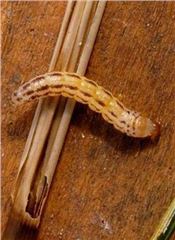Proactive Research to Mitigate the Impact of the Invasive Mexican Rice Borer
James M. Villegas and Blake E. Wilson
The invasive Mexican rice borer (Eoreuma loftini)has become increasingly problematic in Louisiana in recent years and threatens both rice and sugarcane, the two most important crops in the southern part of the state. Adult moths lay eggs on grasses and larvae feed internally within stems hindering plant growth and damaging crop yields (Figure 1). Fortunately, the threat to Louisiana’s agriculture was identified before the pests’ arrival, and proactive research began in Texas as early as 2000 to examine the pest’s ecology and identify potential management strategies. Now that the pest has become established in much of the southwest and central regions of the state, that research is being refined, adapted and applied to help provide pest management solutions that can mitigate its impact.
Mexican Rice Borer Range Expansion
Since this insect pest was first detected in southwest Louisiana in Calcasieu parish in 2008, its expansion into the state has been monitored through the use of pheromone-baited traps. This program detects Mexican rice borer expansion before infestations can be observed in the field. Over the past 13 years, the pest’s range has steadily advanced eastward and northward into the state. Most recently, the Mexican rice borer was found in Rapides and Avoyelles parishes (Figure 2). This is the farthest north the pest has been observed in Louisiana. These new detections mark the first major expansion since the Mexican rice borer was found in the Bayou Teche sugarcane production region in 2018.
To date, this pest has been detected across 16 parishes, and continued range expansion is expected in the coming years. Although there is not much that can be done to halt the spread of the Mexican rice borer, some steps can be taken to prevent human-aided introductions into new regions. Potentially infested seed cane or other grass materials should not be moved into areas where this pest does not yet occur. When transporting infested sugarcane to the mills during harvest, avoid overfilling wagons that may drop billets along the highways.
Pest Status in Rice
The Mexican rice borer has become firmly established in the rice production areas in southwest Louisiana and where it now occurs at high population densities. Rice plants infested with larvae often have blanked panicles called “whiteheads” (Figure 3). The incidence of whiteheads at the AgCenter’s H. Rouse Caffey Rice Research Station in Crowley has increased more than 10-fold since 2015. Yield losses in rice planted within the recommended planting window of March 15 to April 15 are relatively minimal, but yield losses can reach 10% to 15% or greater in late-planted rice. Mexican rice borer control can be achieved with the application of chlorantraniliprole seed treatments that are applied primarily for rice water weevils. Some rice varieties possess resistance to stem borers and experience low injury levels. Ongoing research is aiming to reduce reliance on chemical controls to enhance the sustainability of rice production.
Pest Status in Sugarcane
The Mexican rice borer is a devastating pest of sugarcane in south Texas where yield losses of greater than 40% and even total crop loss have been reported. However, the pest is not anticipated to reach such damaging levels here because of greater levels of rainfall. Low numbers of Mexican rice borers have been infesting sugarcane in the westernmost Louisiana sugarcane production regions since 2012. The species has been the predominant borer in Vermilion Parish since 2019 and potentially damaging infestations are frequently observed. In 2020, Mexican rice borer infestations requiring insecticidal control were detected across substantial sugarcane acreage in Vermilion, Lafayette, St. Landry and Rapides parishes. Fortunately, crop consultants have been managing a similar pest, the sugarcane borer, for decades and nearly every acre of sugarcane in the state is scouted for infestations throughout the summer. Ongoing research is examining varietal resistance, chemical control and scouting strategies to mitigate the impact of the Mexican rice borer as the pest continues to expand towards key sugarcane producing regions along the Mississippi River and Bayou Lafourche.
Future Research
AgCenter entomologists have received U.S. Department of Agriculture funding for a multiyear study of the Mexican rice borer population genetics beginning in 2022. This project will examine genetic changes that have occurred as the species spread from Mexico, across Texas and into Louisiana. The project also aims to identify the source of a population that was introduced into Florida in 2012 and determine changes in cold tolerance that have occurred as the species moved northward. ∆
James M. Villegas is a research associate in the Department of Entomology, and Blake E. Wilson is an assistant professor and field crops entomologist at the Sugar Research Station, St. Gabriel, Louisiana.
(This article appears in the winter 2022 issue of Louisiana Agriculture.)
